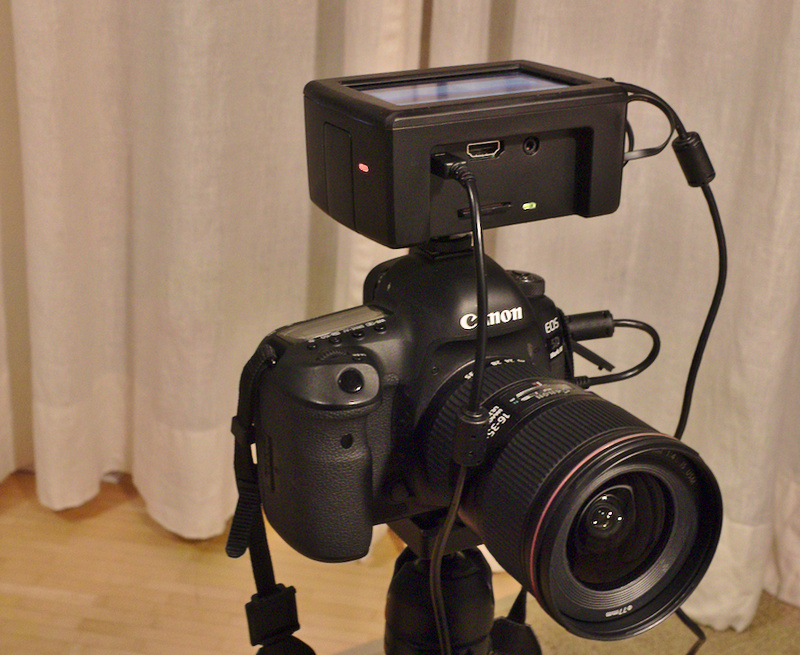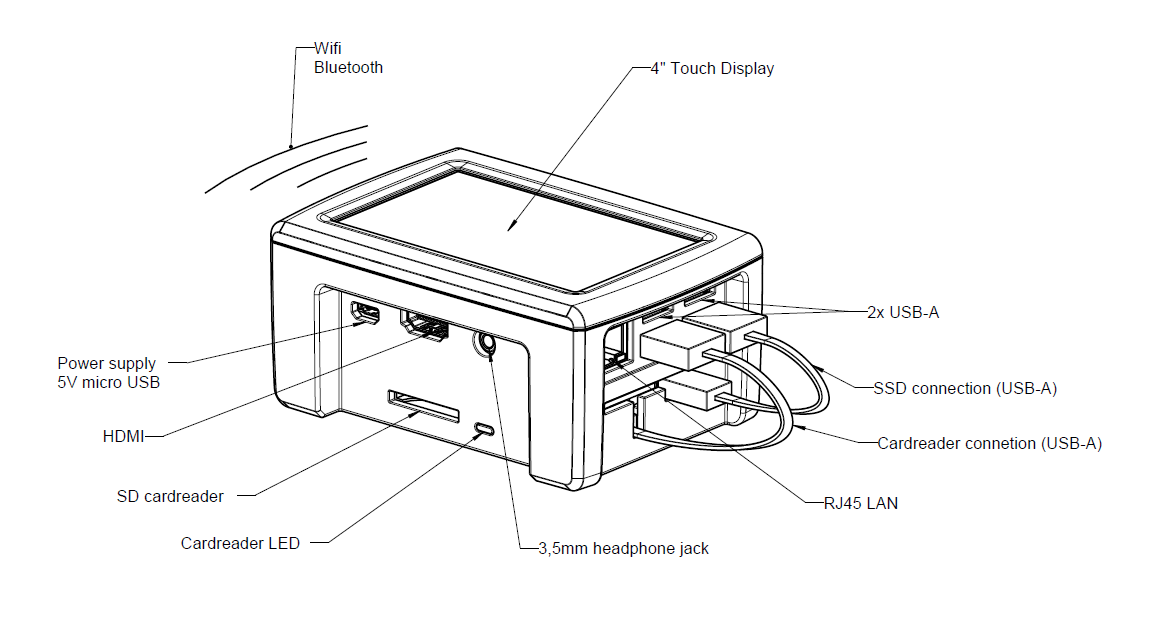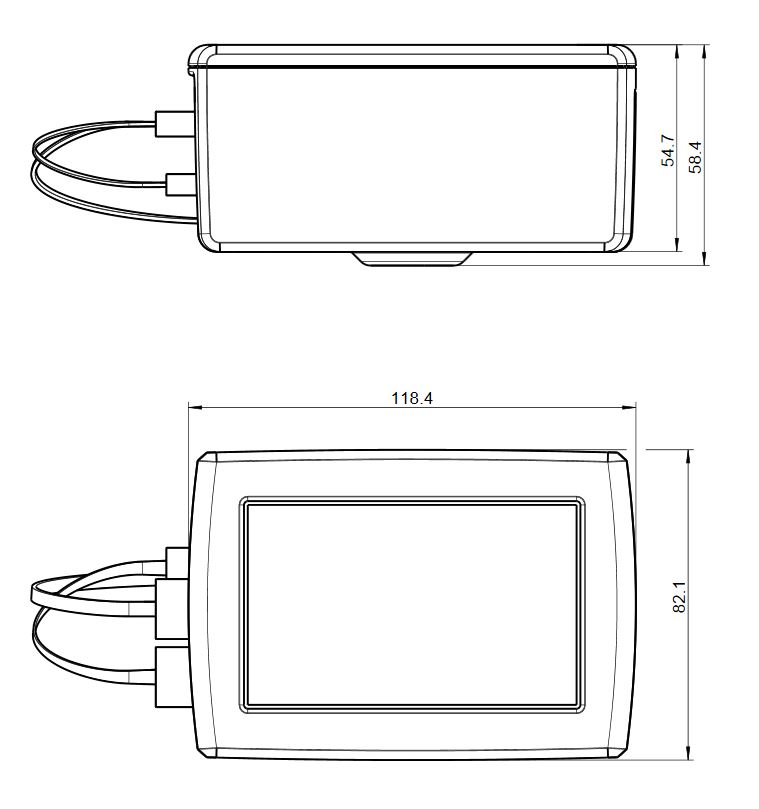Das Advanced Camera Device ist ein DIY Projekt. Sie müssen das Gerät also selber zusammenbauen, aber keine Angst, Sie benötigen keinen Lötkoben, sondern nur einen Schraubendreher und etwas Kleber. Auch ein ungeüber bekommt das Gerät in unter 1 Stunde montiert.
Stückliste
| Position | Anzahl (Stk.) | Artikelnummer | Benennung | Hersteller | Lieferant |
| 1 | 1 | Raspberry Pi 3 Model B oder B+ Unterschiede siehe Kaufempfehlung |
Raspberry Pi Foundation | ||
| 2 | 1 | Micro SD-Karte mit UHS-I min. 8GB z.B. SanDisk Ultra, siehe Kaufempfehlung |
Diverse |
|
|
| 3 | 1 | Renkforce Raspberry Pi USB zu M.2 SATA SSD Konverter | Renkforce (Conrad) | ||
| 4 | 1 | Renkforce Raspbery PI Erweiterungsplatine für SDXC-Karte | Renkforce (Conrad) | ||
| 5 | 1 | Pimoroni HyperPixel 4.0 Touch Display (Achtung ist gibt auch eine Display Version ohne Touch!) |
Pimoroni | ||
| 2 | deleyCON USB Kabel, MK-MK2321 0,15m | deleyCON | |||
| 6 | 1 | M.2 SATA SSD nach ihrer Wahl 16GB bis 2TB möglich Siehe Liste unten. |
Diverse |
|
|
| 7 | 1 | Schraube M2,5 x 7 (*) | Bopla | ||
| 8 | 4 | Distanzbolzen 8 mm, M2.5 (*) | S.A BOURQUI JEAN | ||
| 9 | 4 | Distanzbolzen 12 mm, M2.5 (*) | S.A BOURQUI JEAN | ||
| 10 | 1 | 1/4 Zoll - 20 UNC Sechskantmutter Stahl (*) | - | ||
| 11 | 1 |
ACD Gehäuseteile (CAD Daten siehe weiter unten) Kit bei ebay erhältlich |
Zum selber drucken (HP Multi Jet Fusion) |
(*) Im Multimedia4Linux Montagekit enthalten
Getestete M.2 SATA SSD's
Bitte beim Kauf der SSD die Herstellerangabe beachten. Die folgenden SSD's wurden mit dem Renkforce Konverter erfolgreich getestet:
| Speicherkapazität | Bezeichnung | Artikel | Hersteller | Lieferant |
| 500GB | WD Blue 3D NAND SATA SSD | WDS500G2B0B | Western Digital |
Kalkulation

Empfohlenes Zubehör
| Position | Anzahl (Stk.) | Artikelnummer | Benennung | Hersteller | Lieferant |
| 1 | 1 | Blitzschuhadapter | China import | Ebay | |
| 1 | 1 | Blitzschuhadapter mit Gelenk / Kugelgelenk | Diverse | ||
| 2 | 1 | Powerbank Anker PowerCore 13000 | Anker | Anker | |
| 3 | 1 | Ladegerät / Stromversorgung Anker PowerPort+ 1 mit Quick Charge 3.0 | Anker | Anker |
Gehäuse 3D-Druck Daten
- Multimedia4Linux 3D-Druck Lizenz
- Multimedia4Linux Montagekit
- STL 3D-Druck Daten ACD-Gehäuse
- STL 3D-Druck Daten NAS-Gehäuse (Design wie ACD jedoch ohne Kartenleser und Stativgewinde)
Montageanleitung
Betriebssystem
Für das Betriebssystem benötigen Sie eine 8Gb große micro SD-Karte. Die Karte sollte möglichst schnell sein, damit das Gerät schnell bootet und die Programme auch schnell gestartet werden. Wie man das Betriebsystem Image auf die SD-Karte überträgt können auf der ACD-OS installieren Seite nachlesen.
- Betriebssystem Image ACD-OS 1.0.0 (3,6GB, md5sum -> e8d20697599fa23d24f22731bcd95066)
- Betriebssystem Image ACD-OS 1.1.0 (3,9GB, md5sum -> 05abaf8ed9a9f5f0ec3871a56067a6fc)
- Betriebssystem Image ACD-OS 1.2.0 (4,1GB, md5sum -> 2978b6f8ad7891a92b54135e9d56834a)
- Betriebssystem Image ACD-OS 1.2.1 (2,8GB, md5sum -> 4f9964e54e3ca17a071d9623da7c5f2f)
- Betriebssystem Image ACD-OS 1.2.2 (2,8GB, md5sum -> eed510ababc615b16b450e1749599622)
- Betriebssystem Image ACD-OS 1.2.3 (2,8GB, md5sum -> 854ef98bebd773468d80643efe9f8473)
- Betriebssystem Image ACD-OS 1.3.0 (3,0GB, md5sum -> 77084705a1c195f87c5ad7a31a01d6d1)
- Betriebssystem Image ACD-OS 1.3.1 (3,0GB, md5sum -> 2df795d1da23352ceacb8d234b127629)
- Betriebssystem Image ACD-OS 1.3.2 (3,0GB, md5sum -> aac3e93cc5411ffb7e5ad0bb4d1b9300)
Bedienungshandbuch
Zurück zum Advanced Camera Device
The Advanced Camera Device is a DIY project. So you have to assemble the device yourself, but do not worry, you do not need a soldering iron, just a screwdriver and some glue. Also a ungeuber gets the device in under 1 hour mounted.
Parts list
| Pos. | Parts |
Item number | Name | Producer | Supplier |
| 1 | 1 | Raspberry Pi 3 Model B or B+ | Raspberry Pi Foundation | ||
| 2 | 1 | Micro SD-card with UHS-I min. 8GB e.g. SanDisk Ultra |
Various |
|
|
| 3 | 1 | Renkforce Raspberry Pi USB to M.2 SATA SSD converter | Renkforce (Conrad) | ||
| 4 | 1 | Renkforce Raspbery PI USB to SD 3.0 (SDXC) converter | Renkforce (Conrad) | ||
| 5 | 1 | Pimoroni HyperPixel 4.0 Touch Display (Attention is also a display version without touch!) |
Pimoroni | ||
| 2 | deleyCON USB Cable, MK-MK2321 0,15m | deleyCON | |||
| 6 | 1 | M.2 SATA SSD at your choice 16GB to 2TB possible e.g. Intenso M.2 SATA SSD 256GB |
Various |
|
|
| 7 | 1 | Screw M2,5 x 7 (*) | Bopla | ||
| 8 | 4 | Spacer 8 mm, M2.5 (*) | S.A BOURQUI JEAN | ||
| 9 | 4 | Spacer 12 mm, M2.5 (*) | S.A BOURQUI JEAN | ||
| 10 | 1 | 1/4 Zoll - 20 UNC Nut, Steel (*) | - | ||
| 11 | 1 |
ACD Casing Parts |
for self printing (HP Multi Jet Fusion) |
(*) Included in the Multimedia4Linux assembly kit
Tested M.2 SATA SSD's
Please note the manufacturer's instructions when purchasing the SSD. The following SSDs have been successfully tested with the Renkforce converter:
| Capacitance | Name | Article name | Producer | Supplier |
| 500GB | WD Blue 3D NAND SATA SSD | WDS500G2B0B | Western Digital |
Calculation:

Recommended accessories
| Pos | Parts |
Iten number | Name | Producer | Supplier |
| 1 | 1 | Hot shoe adapter | China import | Ebay | |
| 1 | 1 | Hot shoe adapter with joint / ball joint |
Divers | ||
| 2 | 1 | Powerbank Anker PowerCore 13000 | Anker | Anker | |
| 3 | 1 | Charger / power supply Anker PowerPort+ 1 with Quick Charge 3.0 | Anker | Anker |
Casing 3D-printing data
- Multimedia4Linux 3D-printing license
- Multimedia4Linux assembly kit
- STL 3D-print data ACD-Casing
- STL 3D-print data NAS-Casing (without cardreader and tripod socket)
Assembly Instructions
Operation system
For the operating system you need an 8Gb micro SD card. The card should be as fast as possible, so that the device boots quickly and the programs can be started quickly. How to transfer the operating system image to the SD card you can read here.
- Operatingsystem Image ACD-OS 1.0.0 (3,6GB, md5sum -> e8d20697599fa23d24f22731bcd95066)
- Operatingsystem Image ACD-OS 1.1.0 (3,9GB, md5sum -> 05abaf8ed9a9f5f0ec3871a56067a6fc)
- Operatingsystem Image ACD-OS 1.2.0 (4,1GB, md5sum -> 2978b6f8ad7891a92b54135e9d56834a)
- Operatingsystem Image ACD-OS 1.2.1 (4,1GB, md5sum -> 4f9964e54e3ca17a071d9623da7c5f2f)
- Operatingsystem Image ACD-OS 1.2.2 (2,8GB, md5sum -> eed510ababc615b16b450e1749599622)
- Operatingsystem Image ACD-OS 1.2.3 (2,8GB, md5sum -> 854ef98bebd773468d80643efe9f8473)
- Operatingsystem Image ACD-OS 1.3.0 (3,0GB, md5sum -> 77084705a1c195f87c5ad7a31a01d6d1)
- Operatingsystem Image ACD-OS 1.3.1 (3,0GB, md5sum -> 2df795d1da23352ceacb8d234b127629)
- Operatingsystem Image ACD-OS 1.3.2 (3,0GB, md5sum -> aac3e93cc5411ffb7e5ad0bb4d1b9300)
Manual
Back to the Advanced Camera Device
The device was successfully tested by me with the Canon EOS 80D and Canon EOS 5D Mark IV.

As of 02/2019 based on qDslrDashboard 3.5.7 and libgphoto 2.5.22, no guarantee of correctness and completeness
Canon
-
EOS 100D
-
EOS 1100D, 1200D
-
EOS 400D, 450D, 500D, 550D, 600D, 650D, 700D, 750D, 760D
-
EOS 50D, 60D, 70D
-
EOS 80D
-
EOS 7D, 7D mk II
-
EOS 6D
-
EOS 5D mk II (some issues with AF point change in LV), 5D mk III
-
EOS 5D mk IV
-
EOS 1D mk II, mk III, mk IV
-
EOS 1Ds mk II, mk III (not listed on gphoto, so backup function is uncertain)
-
EOS 1DX
-
EOS R
Nikon
-
Z6, Z7
-
D5000 (no BULB), D5100 (no BULB). D5200, D5300, D5500, D5600
(wireless need to be activated with the Nikon Snapbridge application) -
D80 (no BULB), D90 (no BULB, no video)
-
D7000 (no BULB), D7100, D7200
-
D300/D300s (no BULB, no video) (some LV limitations for now)
-
D600/D610
-
D700 (no BULB, no video) (some LV limitations for now)
-
D500 (wireless need to be activated with the Nikon Snapbridge application)
-
D750, D800, D800E, D810, D810A,
-
D7500, D850 (wireless need to be activated with the Nikon Snapbridge application)
-
D3 (no BULB, no video), D3s (no BULB, no video), D3x (no BULB, no video)
-
D4, D4s, D5
-
D3000, D3100, D3200, D3300, D3400
cameras have limited remote functionality and only basic control is available. There is no BULB, no video recording, no AF point change in LV, and no many other functions.
Sony
ILCE with built-in WiFi and "Smart remote control" app from PlayMemories installed (always use latest version https://www.playmemoriescameraapps.com/ ... _00-F00002):
-
a6000, a6300, a6500,
-
a7, a7S, a7R, a7II, a7S II, a7R II.
Back to the Advanced Camera Device
Das Advanced Camera Device unterstützt viele DSLR und DSLM Kameras von Canon, Nikon und Sony, aber nicht alle, daher lohnt ein Blick in die unten stehende Tabelle. Die Tabelle ist eine Schnittmenge aus den unterstützen Kameras vom qDslrDashboard und libgphoto2. Die Bibliothek von libgphoto2 kann sehr einfach über das ACD aktualisiert werden.
Das Gerät wurde von mir mit der Canon EOS 80D und Canon EOS 5D Mark IV erfolgreich getestet.

Stand 02/2019 auf Basis von qDslrDashboard 3.5.7 und libgphoto 2.5.22, kein Gewähr auf Richtig- und Vollständigkeit
Canon
-
EOS 100D
-
EOS 1100D, 1200D
-
EOS 400D, 450D, 500D, 550D, 600D, 650D, 700D, 750D, 760D
-
EOS 50D, 60D, 70D
-
EOS 80D
-
EOS 7D, 7D mk II
-
EOS 6D
-
EOS 5D mk II (some issues with AF point change in LV), 5D mk III
-
EOS 5D mk IV
-
EOS 1D mk II, mk III, mk IV
-
EOS 1Ds mk II, mk III (nicht bei gphoto gelistet, daher Backupfunktion ungewiss)
-
EOS 1DX
-
EOS R
Nikon
-
Z6, Z7
-
D5000 (no BULB), D5100 (no BULB). D5200, D5300, D5500, D5600
(wireless need to be activated with the Nikon Snapbridge application) -
D80 (no BULB), D90 (no BULB, no video)
-
D7000 (no BULB), D7100, D7200
-
D300/D300s (no BULB, no video) (some LV limitations for now)
-
D600/D610
-
D700 (no BULB, no video) (some LV limitations for now)
-
D500 (wireless need to be activated with the Nikon Snapbridge application)
-
D750, D800, D800E, D810, D810A,
-
D7500, D850 (wireless need to be activated with the Nikon Snapbridge application)
-
D3 (no BULB, no video), D3s (no BULB, no video), D3x (no BULB, no video)
-
D4, D4s, D5
-
D3000, D3100, D3200, D3300, D3400
cameras have limited remote functionality and only basic control is available. There is no BULB, no video recording, no AF point change in LV, and no many other functions.
Sony
ILCE with built-in WiFi and "Smart remote control" app from PlayMemories installed (always use latest version https://www.playmemoriescameraapps.com/ ... _00-F00002):
-
a6000, a6300, a6500,
-
a7, a7S, a7R, a7II, a7S II, a7R II.
Zurück zum Advanced Camera Device

Rechner
| Raspberry Pi | Model 3B (auch 3B+ möglich, Infos siehe Kaufempfehlung) |
| SoC | Broadcom BCM2837B0 |
| CPU | Cortex-A53, 1,4 MHz |
| GPU | Broadcom Dual Core VideoCore IV, OpenGL-ES 1.1/2.0, Full HD 1080p30 |
| RAM | 1Gb |
| Kartenslot | 1x microSD |
| USB | 4x USB-A |
| LAN | 100 Base Ethernet |
| W-LAN | IEEE-802.11 a/b/g/n |
| Bluetooth | 4.1 Low Energy |
| HDMI | (Typ A) V1.3a Anschluss (Ausgang), Full-HD-Auflösung (1080p30 H.264 high-profile) |
| Kopfhöreranschluss | 3,5mm Klinkenanschluss |
Display
| Typ | Kapazitives IPS Touch Display |
| Größe | 4 Zoll (58,5mm x 97mm) |
| Auflösung | 800 x 480 Pixel (~235 PPI) |
| Kontrast | 500:1 (Outdoor geeignet) |
| Betrachtungswinkel | 160° |
| Farbtiefe | 18 Bit (262,144 Farben) |
Datenspeicher
| Typ | M.2 SATA SSD Modul |
| Formate | 2280, 2260, 2242 und 2230 |
| Kapazität | 16 GB bis 2 TB |
| Schnittstelle | USB-A, USB Spezifikation 2.0 |
| Dateisystem | exfat |
| Unterstützte Betriebsysteme | Kann über die USB-Schnittstelle mit Windows, MacOS und Linux verwendet werden |
Kartenleser
| Typ | SD-Kartenleser |
| Kartentyp | SD, SDHC und SDXC mit bis zu 2TB |
| Schnittstelle | USB-A, USB Spezifikation 2.0 |
| Dateisystem | fat, vfat, exfat |
Stromversorgung
| Micro USB | Micro USB power supply (2.1 A) |
| Mobil | Powerbank, Empfehlung Anker PowerCore 13000 |
| Netz | Raspberry Pi Netzteil oder leistungsstarkes Ladegrät für Mobiltelefon, Empfehlung Anker PowerPort+ 1 mit Quick Charge 3.0 |
Gehäuse
| Farbe | matt schwarz |
| Werkstoff | Polyamid |
| Adapter | 1/4" Mutter im Boden für Befestigung auf einem Stativ oder über einen Adapter auf dem Blitzschuh der Kamera |
Software ACD-OS
| Betriebssystem Raspbian |
Advanced Camera Device OS 1.0.0 |
| Kamerasteuerung qDslrDashboard |
3.5.7 (Die Software ist nicht in der Distrubution enthalten, kann aber beim ersten Booten über eine automatisch Abfrage nachinstalliert werden (Internetverbindung notwendig) |
|
Backupsystem |
2.5.20 / 2.5.22 |
Allgemeine Angaben
| Abmessung | 118,4mm x 82,1mm x 58,4mm |
| Gewicht |
350g (ohne Akku) |

Zurück zum Advanced Camera Device



